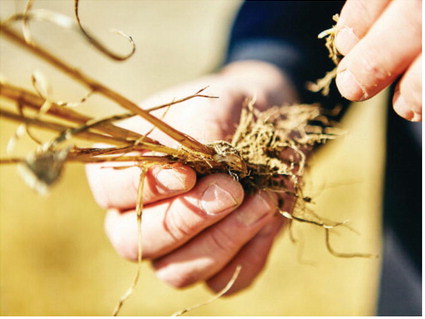MSU Graduate Students Publish New Explorations Of Wheat Stem Sawfly Management


study plot near Amsterdam, Montana.
Montana State University professor Dave Weaver examines a wheat stem sample at a
Two graduate students in Montana State University’s College of Agriculture have published new research on two aspects of management for one of the region’s most damaging agricultural pests.
Wheat stem sawflies cost agricultural producers millions of dollars in losses each year, according to the Montana Wheat and Barley Committee. Surveys conducted by the National Agricultural Statistics Service found that nearly a quarter of respondents in Montana had lost up to 10% of their yield to the pest, and total losses statewide for 2024 were estimated at $66 million.
Doctoral student Jackson Strand and master’s student Lochlin Ermatinger in the Department of Land Resources and Environmental Sciences worked alongside MSU professor David Weaver to explore two aspects of sawfly management. Their novel approaches help better understand the pest’s impact and vulnerabilities.
Strand’s research has examined the impact of smooth brome, a common grass in Montana, on sawfly populations in wheat. Ermatinger applied remote sensing techniques to develop a model predicting sawfly infestation. Both students published their findings this fall, Strand in the Journal of Economic Entomology and Ermatinger in the journal Remote Sensing.
“There’s a strong demand for solutions other than pesticides — which don’t work for wheat stem sawfly — and finding a solution that’s sustainable for growers who may not have a lot of time or resources to do things like plant different crops,” said Strand of his research. “We’re trying to figure out if smooth brome is beneficial and if we can help promote populations of parasitoids that otherwise sometimes fluctuate across seasons and regions.”
Parasitoids are insects that act as biocontrols, in this case against wheat stem sawflies. Parasitoids can go about this in different ways, but the ones Ermatinger focused on operate by paralyzing and then eating the sawfly larvae that feed inside wheat stems. Because parasitoids are native insects, they show potential as a natural management tool to mitigate damage, Strand said. He found that if smooth brome is present near wheat fields, both the sawflies and the parasitoids may gravitate to it.
Through greenhouse experiments and laboratory analysis, Strand sought to identify why that might be by measuring and comparing the volatiles released by smooth brome and
Wheat Stem
wheat. Volatiles are naturally occurring chemicals released by plants, increasing in intensity when they are under stress.
“The plants that were exposed to sawflies expressed different compounds than the ones that weren’t,” said Strand, who completed his undergraduate degree at the University of Minnesota before arriving at MSU in 2021 to begin graduate studies. “Smooth brome produces the same compounds as the wheat, but in higher quantities. The sawflies are triggering a stress response in the plant, and then the parasitoids are keying in on those compounds and finding their hosts.”
Smooth brome is not a native plant, Strand said, but is widespread around Montana, particularly near roadways, where it was once used to mitigate erosion.
(MSU photo by Adrian Sanchez-Gonzalez)
While intentionally planting brome isn’t recommended, he noted that fostering what already exists could provide an appealing alternative for sawflies, consequentially protecting nearby wheat crops.
“By not mowing it or by occasionally fertilizing it to maintain stands, you can make brome more valuable to sawflies, and also valuable to the parasitoids that help control them,” said Strand, who completed his master’s degree in entomology this fall and will continue at MSU to begin his doctoral studies later this month.
While Strand’s research focused on managing known infestations of sawfly, Ermatinger explored new ways to identify and predict infestation in the first place.
Ermatinger, who is originally


